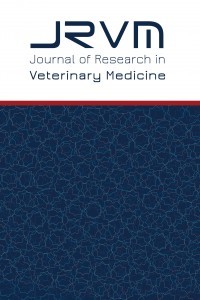Türkiye’de Yarış Atlarında Tendinitis ile Etiyolojik Faktörler Arasındaki İlişki: Yarışların Etkisi
Tendinitis, Türkiye’deki İngiliz ve Arap Yarış Atları, Yarış Sayısı, Yarış Mesafesi, Pist Zemini, Koşu Yönü
Relationship between Tendinitis and Etiologic Factors in Race Horses in Turkey: Effect of the Races
Tendonitis, Thoroughbred and Arabian racehorses in Turkey, Race Numbers, Race Distances, Racetrack Surface, Running Directions,
___
- 1. Seyrek-İntaş D, Kaya M, Çelimli N. Atlarda tendo hastalıklarında ultrasonografik muayenenin sağaltım yönteminin seçimi üzerine etkisi. Veteriner Cerrahi Dergisi. 2002;8(1-2):35-40.
- 2. Cherdchutham W, Meershoek L S, Weeren P R, et al. Effects of exercise on biomechanical properties of the superficial digital flexor tendon in foals. Am J Vet Res. 2001;62(12):1859-1864.
- 3. Cherdchutham W. The equine superficial digital flexor tendon: the ınfluences on exercise on early development and of diathermy on tendon healing. Ph.D. Thesis Utrecht University, ISBN 90-393-2739-4, The Netherlands, Utrecht, 2001.
- 4. Genovese R L, Reef V B, Longo K L, et al. Superficial digital flexor tendonitis-long term sonographic and clinical study of racehorses, Dubai International Equine Symposium Proceedings. 1996;187-205.
- 5. Oikawa M A, Kasashima Y. The Japanese experience with tendonitis in racehorses. J Equine Sci, 2002;13(2),41-56.
- 6. Oikawa M A. Some aspects of tendinitis in thoroughbred racehorses in Japan. Japan Racing Journal;10(5):2002.
- 7. Wilson J H, Robinson R A, Jensen R C, et al. Equine soft tissue injuries associated with racing descriptive statistics from american racetracks. Dubai International Equine Symposium Proceedings. 1996;1-21.
- 8. Dowling B A, Dart A J, Hodgson D R, et al. Superficial digital flexor tendonitis in the horse. Equine Vet J. 2000;32(5):369-378.
- 9. O’Sullivan C B. Injuries of the flexor tendons: focus on the superficial digital flexor tendon, Clin Tech Equine Pract. 2007;6:189-197.
- 10. Watkins J P. Tendon and Ligament Biology. In: Auer J A, Stick J A, ed. Equine Surgery. 2nded. ISBN 0-7216-7733-9, USA, WB Saunders Company; 1999:704-711
- 11. Mcilwraith C W. Chapter 7: Diseases of Joints, Tendons, Ligaments, and Related Structures. In: Stashak T S, ed. Adams’ Lameness in Horses. 5thed. Lipponcott Williams &Wilkins, ISBN: 0-683-07981-6, USA, 2002: 459-640.
- 12. Genovese R, Longo K, Brethold B, et al. Quantitative sonographic assessment in the clinical management of superficial digital flexor ınjuries in thoroughbred racehorses. AAEP Proceedings. 1997;43:285-290.
- 13. Kalisiak O. Parameters influencing prevalence and outcome of tendonitis in Thoroughbred and Arabian racehorses. Pol J Vet Sci. 2012;15(1):111-118.
- 14. Takahashi T, Kasashima Y, Ueno Y. Association between race history and risk of superficial digital flexor tendon injury in Thoroughbred racehorses. J Am Vet Med Assoc. 2004;225(1):90-93.
- 15. Marr C M, Love S, Boyd J S, et al. Factors affecting the clinical outcome of injuries to the superficial digital flexor tendon in National Hunt and Point-to-Point Racehorses. Vet Rec. 1993;132:476-479.
- 16. Türkiye Jokey Kulübü Derneği At Yetiştiricileri ve Yarışları İktisadi İşletmesi Resmi Web Sayfası. http://www.tjk.gov.tr. Accessed August 08, 2019.
- 17. Gillis C, Meagher D M, Pool R R, et al. Ultrasonografically detected changes in equine superficial digital flexor tendons during the first months of race training. Am J Vet Res. 1993;54(11):1797-1802.
- 18. Patterson-Kane J C, Wilson A M, Firth E C, et al. Exercise-related alterations in crimp morphology in the central regions pf superficial digital flexor tendons from young thoroughbreds: a controlled study. Equine Vet J. 1998;30(1):61-64.
- 19. Kasashima Y, Takahashi T, Smith R K, et al. Prevalence of superficial digital flexor tendonitis and suspensory desmitis in Japanese Thoroughbred flat racehorses in 1999. Equine Vet J. 2004;36(4):346-350.
- 20. Alzola R, Easter C, Riggs C M, et al. Ultrasonographic-based predictive factors influencing successful return to racing after superficial digital flexor tendon injuries in flat racehorses: A retrospective cohort study in 469 Thoroughbred racehorses in Hong Kong. Equine Vet J. 2018;50:602–608.
- 21. Kişisel Görüşme; Mehmet Şirin BOZKURT, TJK Genel Müdür Yardımcısı, Eski Bursa Osmangazi Hipodrom Müdürü, E-posta: mehmets@tjk.org
- 22. Whitcomb M B. Ultrasonographic evaluation of the metacarpus, metatarsus, and pastern. Clin Tech Equine Pract. 2004;3:238-255.
- 23. Henklewski R, Atamaniuk W. Ultrasound evaluation of flexor tendon injuries in half – breed racing horses at the partynice racing track in Wrocław, Poland, EVDI Meeting Proceeding book. Svolvaer, Norway, 2008;59.
- Başlangıç: 1981
- Yayıncı: Bursa Uludağ Üniversitesi
Muhammed DUMAN, Izzet Burcin SATİCİOGLU, Burak OZDEMİR, Nihed AJMİ, Soner ALTUN
Gökçen GÜVENÇ BAYRAM, Ebru YALÇIN ÜLGER, Murat YALÇIN
Duygu GÖK YURTSEVEN, Zehra MİNBAY, Özhan EYİGÖR
Mezenkimal Kök Hücrelerin Tanımlanması ve Proliferasyon Özellikleri
Kollajenin Saanen Teke Spermasının Dondurulabilirliği Üzerine Etkisi
Burcu ÜSTÜNER, Ahmet AKTAR, Mehmet YILMAZ, Emine MÜLKPINAR, Elif GÖKÇE, Ezgi BOZ, Selim ALÇAY, Şenay UÇAR
Türkiye’de Yarış Atlarında Tendinitis ile Etiyolojik Faktörler Arasındaki İlişki: Yarışların Etkisi
G. Ülke ÇALIŞKAN, Deniz SEYREK İNTAŞ, Nureddin ÇELİMLİ
Asm Golam KIBRIA, Shah NAWAZ, Özlem ÖZDEN AKKAYA, Tayfun DİKMEN, Artay YAĞCI
Pestisit Kullanımının Bal Arısı Sağlığına ve Ürünlerine Etkisi
